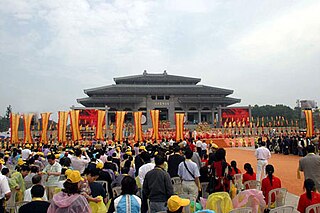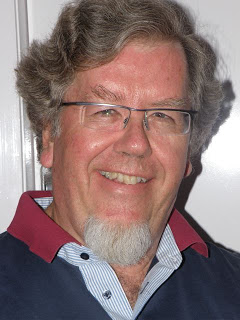Related Research Articles

New Age is a range of spiritual or religious practices and beliefs which rapidly grew in the Western world during the 1970s. Precise scholarly definitions of the New Age differ in their emphasis, largely as a result of its highly eclectic structure. Although analytically often considered to be religious, those involved in it typically prefer the designation of spiritual or Mind, Body, Spirit and rarely use the term New Age themselves. Many scholars of the subject refer to it as the New Age movement, although others contest this term and suggest that it is better seen as a milieu or zeitgeist.

Shamanism is a religious practice that involves a practitioner who is believed to interact with a spirit world through altered states of consciousness, such as trance. The goal of this is usually to direct these spirits or spiritual energies into the physical world, for healing, divination or another purpose.
The meaning of spirituality has developed and expanded over time, and various connotations can be found alongside each other. Traditionally, spirituality referred to a religious process of re-formation which "aims to recover the original shape of man", oriented at "the image of God" as exemplified by the founders and sacred texts of the religions of the world. The term was used within early Christianity to refer to a life oriented toward the Holy Spirit and broadened during the Late Middle Ages to include mental aspects of life. In modern times, the term both spread to other religious traditions and broadened to refer to a wider range of experience, including a range of esoteric traditions and religious traditions. Modern usages tend to refer to a subjective experience of a sacred dimension and the "deepest values and meanings by which people live", often in a context separate from organized religious institutions. This may involve belief in a supernatural realm beyond the ordinarily observable world, personal growth, a quest for an ultimate or sacred meaning, religious experience, or an encounter with one's own "inner dimension."
Huna is the word adopted by Max Freedom Long (1890–1971) in 1936 to describe his theory of metaphysics. Long cited what he believed to be the spiritual practices of the ancient Hawaiian kahunas (priests) as inspiration; however, contemporary scholars consider the system to be his invention designed through a mixture of a variety of spiritual practices from various cultures, with roots in New Thought and Theosophy, rather than in traditional Hawaiian beliefs. Huna is part of a New Age [non-Hawaiian] movement.
Timothy James Fox is an American priest and theologian. Formerly a member of the Dominican Order within the Catholic Church, he became a member of the Episcopal Church following his expulsion from the order in 1993.

Eckhart Tolle is a German-born spiritual teacher and self-help author who resides in Canada. He is best known as the author of The Power of Now and A New Earth: Awakening to Your Life's Purpose.
A religious experience is a subjective experience which is interpreted within a religious framework. The concept originated in the 19th century, as a defense against the growing rationalism of Western society. William James popularised the concept.
Neoshamanism refers to new forms of shamanism. It usually means shamanism practiced by Western people as a type of New Age spirituality, without a connection to traditional shamanic societies. It is sometimes also used for modern shamanic rituals and practices which, although they have some connection to the traditional societies in which they originated, have been adapted somehow to modern circumstances. This can include "shamanic" rituals performed as an exhibition, either on stage or for shamanic tourism, as well as modern derivations of traditional systems that incorporate new technology and worldviews.

Richard Rohr, is an American Franciscan priest and writer on spirituality based in Albuquerque, New Mexico. He was ordained to the priesthood in the Roman Catholic Church in 1970. PBS has called him "one of the most popular spirituality authors and speakers in the world".

Celtic modern paganism refers to any type of modern paganism or contemporary pagan movements based on the ancient Celtic religion.
Neotantra, navatantra or tantric sexuality, is the modern, Western variation of tantra associated with new religious movements. This includes both New Age and modern Western interpretations of traditional Hindu and Buddhist tantric sex. Some of its proponents refer to ancient and traditional texts and principles, and many others use tantra as a catch-all phrase for "sacred sexuality", and may incorporate unorthodox practices. In addition, not all of the elements of Indian tantric practices are used in neotantra, in particular the reliance on a guru.
Plastic shaman, or plastic medicine people, is a pejorative colloquialism applied to individuals who are attempting to pass themselves off as shamans, holy people, or other traditional spiritual leaders, but who have no genuine connection to the traditions or cultures they claim to represent. In some cases, the "plastic shaman" may have some genuine cultural connection, but is seen to be exploiting that knowledge for ego, power, or money.
Ego death is a "complete loss of subjective self-identity". The term is used in various intertwined contexts, with related meanings. In Jungian psychology, the synonymous term psychic death is used, which refers to a fundamental transformation of the psyche. In death and rebirth mythology, ego death is a phase of self-surrender and transition, as described by Joseph Campbell in his research on the mythology of the Hero's Journey. It is a recurrent theme in world mythology and is also used as a metaphor in some strands of contemporary western thinking.

In the study of comparative religion, the East Asian religions or Taoic religions, form a subset of the Eastern religions. This group includes Chinese religion overall, which further includes Ancestral Worship, Chinese folk religion, Confucianism, Taoism and so-called popular salvationist organisations, as well as elements drawn from Mahayana Buddhism that form the core of Chinese Buddhism and East Asian Buddhism at large. The group also includes Japanese Shintoism, Vietnamese folk religion and Korean Muism both identifying the indigenous shamanic religion and ancestor worship of such peoples, which have received influences from Chinese religions throughout the centuries. Chinese salvationist religions have influenced the rise of Korean and Japanese new religions—for instance, respectively, Jeungsanism and Tenriism; these movements draw upon indigenous traditions but are heavily influenced by Chinese philosophy and theology.

Nevill Drury was an English-born Australian editor and publisher, as well as the author of over 40 books on subjects ranging from shamanism and western magical traditions to art, music, and anthropology. His books have been published in 26 countries and in 19 languages.
The Seth Material is a collection of writing dictated by Jane Roberts to her husband from late 1963 until her death in 1984. Roberts claimed the words were spoken by a discarnate entity named Seth. The material is regarded as one of the cornerstones of New Age philosophy, and the most influential channelled text of the post-World War II "New Age" movement, other than the Edgar Cayce books and A Course in Miracles. Jon Klimo writes that the Seth books were instrumental in bringing the idea of channeling to a broad public audience.
The red road is a modern English-language concept of the right path of life, as inspired by some of the beliefs found in a variety of Native American spiritual teachings. The term is used primarily in the Pan-Indian and New Age communities, and rarely among traditional Indigenous people, who have terms in their own languages for their spiritual ways. Native Americans' spiritual teachings are diverse. With over 500 federally-recognized tribes in just the US, while some regional practices and beliefs might be similar, the cultures are highly individualized. Individual ceremonies and particular beliefs tend to be unique to the people of these diverse bands, tribes and nations.

Mysticism is popularly known as becoming one with God or the Absolute, but may refer to any kind of ecstasy or altered state of consciousness which is given a religious or spiritual meaning. It may also refer to the attainment of insight in ultimate or hidden truths, and to human transformation supported by various practices and experiences.

Shamanism: Archaic Techniques of Ecstasy is a historical study of the different forms of shamanism around the world written by the Romanian historian of religion Mircea Eliade. It was first published in France by Librarie Payot under the French title of Le Chamanisme et les techniques archaïques de l'extase in 1951. The book was subsequently translated into English by Willard R. Trask and published by Princeton University Press in 1964.
Yoga philosophy is one of the six major orthodox schools of Hinduism. Ancient, medieval and most modern literature often refers to Yoga-philosophy simply as Yoga, and it is only at the end of the first millennium CE that Yoga is mentioned as a separate school of thought in Indian texts, distinct from Samkhya. The systematic collection of ideas of Yoga-philosophy is found in the Yoga Sutras of Patanjali, a key text of Yoga-philosophy which has influenced all other schools of Indian philosophy.
References
- ↑ The Power of Now: A Guide to Spiritual Enlightenment, New World Library, October, 1999 ISBN 1-57731-152-3 (HC) ISBN 1-57731-480-8 (PB)
- ↑ Practicing the Power of Now: Essential Teachings, Meditations, and Exercises from The Power of Now, New World Library, October 10, 2001 ISBN 1-57731-195-7 (HC)
- ↑ Stillness Speaks: Whispers of Now, New World Library, August 2003 ISBN 1-57731-400-X
- ↑ The Wheel of Time: Shamans of Ancient Mexico, Their Thoughts About Life, Death and the Universe, 1998. ISBN 0-9664116-0-9
- ↑ Knight, J.Z. (1999, rev.2004). Ramtha: The White Book. Yelm, Washington: JZK Publishing.
- ↑ Partnering With God : Practical Information for the New Millennium (Kryon Book Six) (1997) Kryon Writings , ISBN 1-888053-10-0
- ↑ Wallis, Roy (1986), "Religion as Fun? The Rajneesh Movement", Sociological Theory, Religion and Collective Action (Queen's University, Belfast): Pages 191–224, reprinted in Aveling 1999, pp. 129–161
- ↑ http://www.christiancourier.com/articles/437-the-biblical-concept-of-time The Biblical Concept of «Time» By Wayne Jackson
- ↑ Brent D. Slife. Time and Psychological Explanation. SUNY Press 1993. 343 pages
- ↑ Wouter J. Hanegraaff. New Age Religion and Western Culture:Esotericism in the Mirror of Secular Thought. SUNY Press 1998 580 pages
- ↑ Джеймс Льюис The Astrology Book:The Encyclopedia of Heavenly Influences. Visible Ink Press 2003. 928 pages
- ↑ Robert S. Ellwood, Gregory D. Alles. The Encyclopedia of World Religions. Infobase Publishing 2007. 514 pages
- ↑ Adam Possamai. In Search of New Age Spiritualities. Ashgate Publishing, Ltd. 2005 160 pages
- ↑ Daren Kemp. New Age: A Guide : Alternative Spiritualities from Aquarian Conspiracy to Next Age. Edinburgh University Press 2004. 211 pages